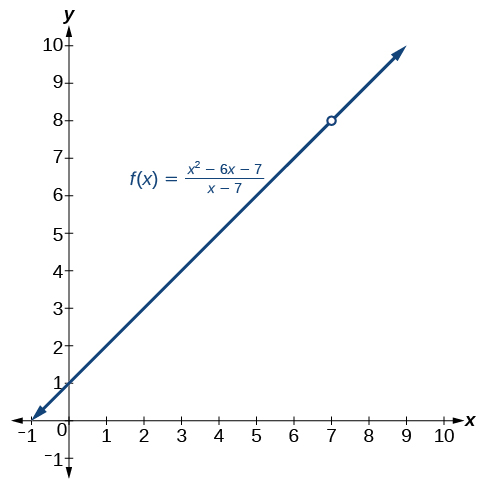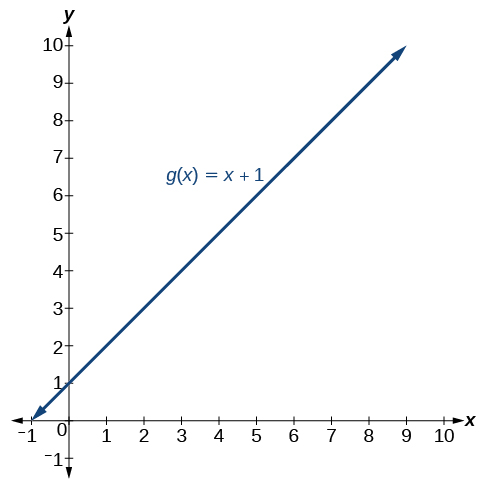12.2: Finding Limits - Properties of Limits
- Last updated
- Nov 4, 2018
- Save as PDF
- Page ID
- 13583
( \newcommand{\kernel}{\mathrm{null}\,}\)
Consider the rational function
The function can be factored as follows:
which gives us
Does this mean the function
The answer is no. Function


(left) The graph of function
So, do these two different functions also have different limits as
Look again at Figure and Figure. Notice that in both graphs, as
Remember that when determining a limit, the concern is what occurs near
Finding the Limit of a Sum, a Difference, and a Product
Graphing a function or exploring a table of values to determine a limit can be cumbersome and time-consuming. When possible, it is more efficient to use the properties of limits, which is a collection of theorems for finding limits.
Knowing the properties of limits allows us to compute limits directly. We can add, subtract, multiply, and divide the limits of functions as if we were performing the operations on the functions themselves to find the limit of the result. Similarly, we can find the limit of a function raised to a power by raising the limit to that power. We can also find the limit of the root of a function by taking the root of the limit. Using these operations on limits, we can find the limits of more complex functions by finding the limits of their simpler component functions.
properties of limits
Let
| Constant, k | |
| Constant times a function | |
| Sum of functions | |
| Difference of functions | |
| Product of functions | |
| Quotient of functions | |
| Function raised to an exponent | |
| nth root of a function, where n is a positive integer | |
| Polynomial function |
Example
Evaluate
Solution
Exercise
Evaluate the following limit:
Solution
26
Finding the Limit of a Polynomial
Not all functions or their limits involve simple addition, subtraction, or multiplication. Some may include polynomials. Recall that a polynomial is an expression consisting of the sum of two or more terms, each of which consists of a constant and a variable raised to a nonnegative integral power. To find the limit of a polynomial function, we can find the limits of the individual terms of the function, and then add them together. Also, the limit of a polynomial function as
how to: Given a function containing a polynomial, find its limit
- Use the properties of limits to break up the polynomial into individual terms.
- Find the limits of the individual terms.
- Add the limits together.
- Alternatively, evaluate the function for
Example
Evaluate
Solution
Exercise
Evaluate
Solution
59
Example
Evaluate
Solution
Exercise
Evaluate the following limit:
Solution
10
Finding the Limit of a Power or a Root
When a limit includes a power or a root, we need another property to help us evaluate it. The square of the limit of a function equals the limit of the square of the function; the same goes for higher powers. Likewise, the square root of the limit of a function equals the limit of the square root of the function; the same holds true for higher roots.
Example
Evaluate
Solution
We will take the limit of the function as
Exercise
Evaluate the following limit:
Solution
−64
Q & A: If we can’t directly apply the properties of a limit, for example in
Yes. Some functions may be algebraically rearranged so that one can evaluate the limit of a simplified equivalent form of the function.
Finding the Limit of a Quotient
Finding the limit of a function expressed as a quotient can be more complicated. We often need to rewrite the function algebraically before applying the properties of a limit. If the denominator evaluates to 0 when we apply the properties of a limit directly, we must rewrite the quotient in a different form. One approach is to write the quotient in factored form and simplify.
Example
Evaluate
Solution
Factor where possible, and simplify.
Analysis
When the limit of a rational function cannot be evaluated directly, factored forms of the numerator and denominator may simplify to a result that can be evaluated.
Notice, the function
is equivalent to the function
Notice that the limit exists even though the function is not defined at
Exercise
Evaluate the following limit:
Solution
Example
Evaluate
Solution
Find the LCD for the denominators of the two terms in the numerator, and convert both fractions to have the LCD as their denominator.
Analysis
When determining the limit of a rational function that has terms added or subtracted in either the numerator or denominator, the first step is to find the common denominator of the added or subtracted terms; then, convert both terms to have that denominator, or simplify the rational function by multiplying numerator and denominator by the least common denominator. Then check to see if the resulting numerator and denominator have any common factors.
Exercise
Evaluate
Solution
how to: Given a limit of a function containing a root, use a conjugate to evaluate
- If the quotient as given is not in indeterminate
- Otherwise, rewrite the sum (or difference) of two quotients as a single quotient, using the least common denominator (LCD).
- If the numerator includes a root, rationalize the numerator; multiply the numerator and denominator by the conjugate of the numerator. Recall that
- Simplify.
- Evaluate the resulting limit.
Example
Evaluate
Solution
Analysis
When determining a limit of a function with a root as one of two terms where we cannot evaluate directly, think about multiplying the numerator and denominator by the conjugate of the terms.
Exercise
Evaluate the following limit:
Solution
Example
Evaluate
Solution
Analysis
Multiplying by a conjugate would expand the numerator; look instead for factors in the numerator. Four is a perfect square so that the numerator is in the form
and may be factored as
Exercise
Evaluate the following limit:
Solution
how to: Given a quotient with absolute values, evaluate its limit
- Try factoring or finding the LCD.
- If the limit cannot be found, choose several values close to and on either side of the input where the function is undefined.
- Use the numeric evidence to estimate the limits on both sides.
Example
Evaluate
Solution
The function is undefined at
Left-hand limit:
Right-hand limit:
Since the left- and right-hand limits are not equal, there is no limit.
Exercise
Evaluate
Solution
Key Concepts
- The properties of limits can be used to perform operations on the limits of functions rather than the functions themselves. See Example.
- The limit of a polynomial function can be found by finding the sum of the limits of the individual terms. See Example and Example.
- The limit of a function that has been raised to a power equals the same power of the limit of the function. Another method is direct substitution. See Example.
- The limit of the root of a function equals the corresponding root of the limit of the function.
- One way to find the limit of a function expressed as a quotient is to write the quotient in factored form and simplify. See Example.
- Another method of finding the limit of a complex fraction is to find the LCD. See Example.
- A limit containing a function containing a root may be evaluated using a conjugate. See Example.
- The limits of some functions expressed as quotients can be found by factoring. See Example.
- One way to evaluate the limit of a quotient containing absolute values is by using numeric evidence. Setting it up piecewise can also be useful. See Example.
Glossary
- properties of limits
- a collection of theorems for finding limits of functions by performing mathematical operations on the limits


